
The Western Front was one of the main theatres of war during the First World War. Following the outbreak of war in August 1914, the German Army opened the Western Front by invading Luxembourg and Belgium, then gaining military control of important industrial regions in France. The German advance was halted with the Battle of the Marne. Following the Race to the Sea, both sides dug in along a meandering line of fortified trenches, stretching from the North Sea to the Swiss frontier with France, which changed little except during early 1917 and in 1918.
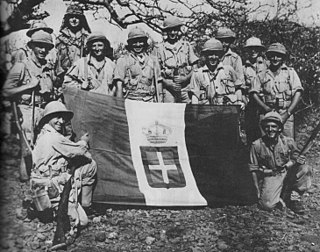
The East African campaign was fought in East Africa during the Second World War by Allies of World War II, mainly from the British Empire, against Italy and its colony of Italian East Africa, between June 1940 and November 1941. The British Middle East Command with troops from the United Kingdom, South Africa, British India, Uganda Protectorate, Kenya, Somaliland, West Africa, Northern and Southern Rhodesia, Sudan and Nyasaland participated in the campaign. These were joined by the Allied Force Publique of Belgian Congo, Imperial Ethiopian Arbegnoch and a small unit of Free French.

The Eastern Front or Eastern Theater of World War I was a theater of operations that encompassed at its greatest extent the entire frontier between Russia and Romania on one side and Austria-Hungary, Bulgaria, the Ottoman Empire, and Germany on the other. It stretched from the Baltic Sea in the north to the Black Sea in the south, involved most of Eastern Europe, and stretched deep into Central Europe as well. The term contrasts with the Western Front, which was being fought in Belgium and France.

The Allies, or the Entente powers, were an international military coalition of countries led by France, the United Kingdom, Russia, the United States, Italy, and Japan against the Central Powers of Germany, Austria-Hungary, the Ottoman Empire, and Bulgaria during the First World War (1914–1918).

Difflugia is the largest genus of Arcellinida, one of several groups of Tubulinea within the eukaryote supergroup Amoebozoa. Arcellinida species produce shells or tests from mineral particles or biogeonic elements and are thus commonly referred to as testate amoebae or shelled amoebae. Difflugia are particularly common in marshes and other freshwater habitats.
A colonial empire is a collective of territories, either contiguous with the imperial center or located overseas, settled by the population of a certain state and governed by that state.

The following events occurred in October 1917:

Arcellinid testate amoebae or Arcellinida, Arcellacean or lobose testate amoebae are single-celled protists partially enclosed in a simple test (shell).

The Canon de 155 C modèle 1917 Schneider, often abbreviated as the C17S, was a French howitzer designed by Schneider. It was essentially the Canon de 155 C modèle 1915 Schneider fitted with a different breech to use bagged propellant rather than the cartridge cases used by the older howitzer. It was used by France, Russian Empire, Belgium, Romania, and the United States from 1917 during World War I and was widely exported after the war. Surviving weapons were in service with France, Poland, Greece, Italy, Belgium, the United States, and Finland during World War II. Captured weapons were used by the Germans for their 2nd-line artillery and coast defense units.

Pachydiscus is an extinct genus of ammonite from the Late Cretaceous and Early Paleocene with a worldwide distribution, and type for the desmoceratacean family Pachydiscidae. The genus' type species is P. neubergicus. Altogether some 28 species have been described.
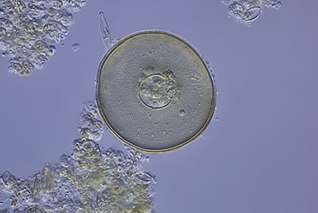
Arcella is a genus of testate amoebae in the order Arcellinida, usually found in freshwaters and mosses, and rarely in soils. A key characteristic of Arcella is the circular test with a hole on its center from where finger-like pseudopods emerge. It is one of the largest testacean genera.

70000 Tons of Metal is an annual heavy metal music festival that takes place on board a cruise ship. The event is a five-day festival, including one shore day at a select Caribbean destination.
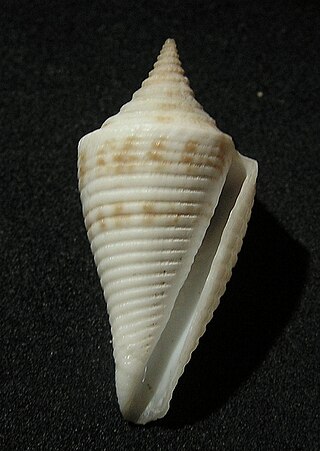
Conasprella is a genus of sea snails, marine gastropod mollusks in the family Conidae, the cone snails and their allies. This genus was formerly treated by some experts as a member of the family Conilithidae and as an "alternative representation" of this group of species.
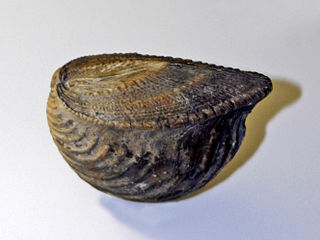
Trigonia is an extinct genus of saltwater clams, fossil marine bivalve mollusk in the family Trigoniidae. The fossil range of the genus spans the Paleozoic, Mesozoic and Paleocene of the Cenozoic, from 298 to 56 Ma.

An amoeba, often called an amoeboid, is a type of cell or unicellular organism with the ability to alter its shape, primarily by extending and retracting pseudopods. Amoebae do not form a single taxonomic group; instead, they are found in every major lineage of eukaryotic organisms. Amoeboid cells occur not only among the protozoa, but also in fungi, algae, and animals.
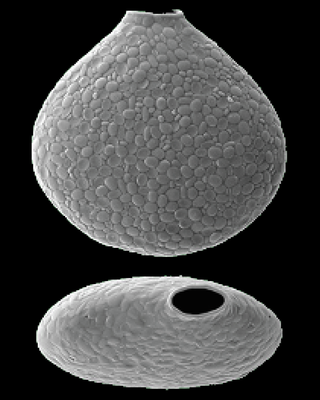
Nebela is a diverse genus of testate amoebae of cosmopolitan distribution, belonging to the family Hyalospheniidae. They are "prey agglutinated" or "kleptosquamic" organisms, meaning they take the inorganic plates from their prey to construct their test.

Cryptodifflugiidae is a family of arcellinid testate amoebae.

Cryptodifflugia leachi is an aquatic species of testate amoebae discovered in 2006 in Canada, living in bottom sediment from wetlands at the base of the Niagara Escarpment.

















